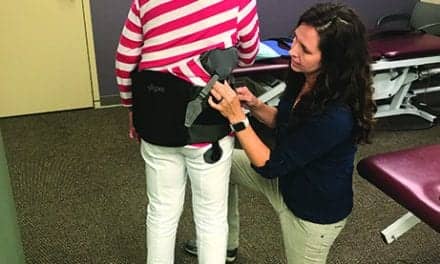Body-worn movement monitors can improve the ability of physical therapists to make accurate measurements of mobility and function.
By Mike Studer, PT, MHS, NCS, CEEAA, CWT, and Fay Bahling Horak, PhD, PT
Body-worn, movement monitors are revolutionizing evidence-based physical therapy. New movement monitors provide accurate, objective measures of functional movements that were previously assessed with subjective evaluations. For example, measurement of standing balance that previously relied upon balance rating scales and the number of seconds that balance could be maintained in a particular posture (such as one leg standing) can now be more sensitively quantified as postural sway during quiet stance and postural responses to therapists’ perturbations.1-3 Measurement of gait that previously relied only upon gait speed and subjective descriptions of quality of gait, can now be characterized as specific spatial and temporal gait qualities such as stride length, double support time, gait asymmetries, and dynamic balance during gait.4-6 Joint range of motion that previously relied upon goniometer measures of static joint position can now be quantified as dynamic range of joint motion during actual functional activities.
Clinical Benefits of Movement Monitors
What are the clinical benefits of new movement monitors for rehabilitation? In the last few years, advances in wireless technology, small movement monitors, and useful software interfaces have translated objective movement monitoring from sophisticated laboratories to the clinic. For example, quantitative gait analysis used to require very expensive and time-consuming, 3-dimensional motion analysis using reflective markers and force plates in sophisticated gait laboratories. Today, similar gait measures can be obtained quickly and automatically with small, portable movement monitors designed to be worn in any environment for long periods of time. Now that body-worn movement monitors have become practical for use in clinical settings, rehabilitation can benefit from:
1) Sensitive measures of impairment and therapeutic outcomes;
2) Identification of specific impairments to better target therapy;
3) Accurate, objective measures that do not depend on therapist expertise;
4) Automatic, longitudinal tracking of patient progress; and
5) Biofeedback applications to encourage proper practice and improve motor learning. With the number of benefits associated with new body-worn sensor systems still emerging, therapists are just beginning to discover all of the new applications that can improve the success of their interventions.
Movement Monitors vs. Activity Monitors
Movement monitors are not like wearable activity monitors. Physical therapists have seen the explosion in availability of personal activity monitors such as Jawbone, Nike FuelBand, Fit-Bit trackers, etc, aimed at encouraging fitness by monitoring body accelerations or estimates of steps made each day. These “activity monitors” provide the user with beneficial information about calories consumed, minutes of activity, distance traveled, or steps taken. They are recording overall “quantity” of movement through the body part where the device is being worn or attached. The overall accuracy and sensitivity of this form of wearable technology varies from device to device, yet the overall data serves a purpose to encourage a more healthy lifestyle. As a trade-off, the single-dimension activity monitor is not engineered to be sensitive enough to accurately reflect mobility in older people who are affected by gait and motor impairments.
In contrast to activity monitors, movement monitors can characterize the “quality” as well as the “quantity” of movements. Movement monitors are also called “inertial sensors.” Unlike activity monitors, movement monitors include gyroscopes that measure angular velocity of the limbs and magnetometers, that, when combined with accelerations and angular velocity, can measure orientation of the limbs and joint range of motion. In fact, when combined with rapid, synchronous data collection form sensors on multiple body segments, movement monitors can provide full-body kinematics, previously only available from digital camera systems.
In addition, more and more sophisticated algorithms are being developed to provide accurate measures of gait, balance, and joint range of motion. For example, whereas activity monitors may be able to report how much of the day a patient was sedentary and how many steps that individual took each day, movement monitors can accurately measure the quality of movement. That is, movement monitors can measure gait impairments such as limping, poor foot clearance, foot drop, and trunk and head instability. Movement monitors can also measure static and dynamic joint range of motion as well as multijoint coordination during a functional task such as sit to stand or reaching.
Software for Measurement
Movement monitors require sophisticated software to be clinically useful. Recently, APDM Inc, based in Portland, Ore, has developed software packages called Mobility Lab and Mobility Clinic for clinical researchers and clinical practitioners, respectively. This user-friendly software provides fast, accurate measures of popular clinical balance and gait tests, such as standing balance (ISway), the Instrumented Timed Up and Go test (ITUG), and the 2-minute walk (IWalk). Standing balance is measured by the area (and other characteristics) of postural sway from a sensor on the lumbar spine.7,8
Normative values are available about amount of sway to expect when standing on a firm surface, on foam, and with eyes open or closed, called the Instrumented Clinical Test of Sensory Orientation for Balance (ICTSIB). Figure 1 (page xx) illustrates a patient wearing an Opal movement monitor by APDM on their belt when standing on foam. The therapist is monitoring the patient’s postural sway and immediately receives data about how the sway area compares to sway among age-matched subjects with good balance, and to the patient’s performance prior to therapy. The ITUG measures how people arise from a chair, gait characteristics, turning velocity and number of steps to turn, and the stand-to sit-transition. IWalk allows long-duration gait characterization to measure gait variability, symmetry, foot clearance, hip hiking, and fatigue. These quick and easy protocols include 1) provider and patient instructions, 2) sophisticated algorithms to automatically extract test measures, 3) comparisons with age-matched normative values, and 4) graphs and summary tables with longitudinal data about a patient to monitor improvement with therapy.
Portable Walkways with Pressure-Sensitive Technology
GAITRite by CIR Systems Inc, Sparta, NJ, is a device offered to the rehabilitation community that incorporates a pressure-sensitive surface, allowing for objective gait analysis. The GAITRite surface uses pressure-sensitive monitors that transmit information about acceleration, speed, and pathway. Additionally, this device can help to objectify how the subject is using/contacting the surface differently with each limb, offering a measure of symmetry in step length, swing/stance time, and weight-bearing.
Another type of walking mat is available from ProtoKinetics, headquartered in Havertown, Pa, and a provider of movement analysis equipment. The Zeno Walkway offered by ProtoKinetics, is designed to detect and collect pressure data during static and dynamic balance and gait assessment. This device features advanced pressure sensing technology as well as the PKMAS program, which uses a variety of movement protocols and yields temporal (timing), spatial (distance), and pressure data through one-click output parameters.
Wearable Technology with Pressure-Sensitive Mapping
Tekscan Inc, based in Boston, has engineered an additional type of body-worn sensor that is available as a shoe-insert pressure map. This device is designed to provide the user or clinician information about forces transmitted through the foot as it comes in contact with the ground. This technology is built to provide insight for both quiet standing and walking, leading to interventions based on symmetry and biomechanical inefficiencies.
Objective Measures of Balance
Objective outcomes can sensitively track changes in function with therapy. The advantage of using objective measures of balance as a sensitive measure of improvement in balance over time can be seen in Figures 2 and 3 (page xx) from a 52-year-old female patient affected by moderate neuropathy who was exposed to a variety of sensory conditions to decrease her visual dependence. Figure 2 shows postural sway as stabilograms from APDM’s Mobility Lab with the patient standing in four sensory conditions: eyes open on a firm surface, eyes closed on a firm surface, eyes open standing on foam, and eyes closed standing on foam.
Baseline testing showed the patient was very dependent on visual information for postural control. During her clinical visits, she practiced walking on a treadmill while moving her head, with eyes closed, or with visual surround motion twice a week for 3 months. Although clinical measures of balance and gait suggested some improvements (the Berg Balance Score increased from 41 to 49/51), her postural sway reduction showed impressive evidence of her improved balance (Figure 3). Such documentation of impairment and improvement can be motivating to the client, therapist, and third-party payors.
Movement Monitors for Rehabilitation
The future is promising for the use of movement monitors in rehabilitation. Measures of balance, gait, and joint motion are not only useful for documentation of impairments, disability, and changes with therapy, but also to improve the rehabilitation process itself. For example, movement monitors can be used to provide real-time biofeedback of body motion and thereby act as a “virtual therapist.” Research has shown that audio or visual or vibrotactile biofeedback about body sway from a movement monitor on the belt can significantly reduce postural sway among patients with vestibular or somatosensory loss.9-11 Such feedback during balance, gait, or joint motion tasks allows patients to practice their exercises with accurate feedback, even when a therapist is not present.
In fact, patients will soon be able to take movement monitors home to practice their exercise program while therapists monitor compliance and quality of movement using telerehabilitation. The new generation of movement monitors is designed to be small enough and powerful enough to permit all-day wear. This allows therapists to measure quality of mobility and joint function in real-life environments for long periods of time. Reports to patients about their progress provide motivation and precision to their practice, even if they cannot travel to a therapy clinic.
Eventually, therapists will be able to contribute accurate reports of their patients’ movement disorders that could help with the diagnosis and clinical decision-making for medical management. For example, do the postural sway characteristics suggest a vestibular or cerebellar disorder? Is the patient with Parkinson’s disease a good candidate for deep brain stimulation surgery because of their daily mobility fluctuations? Should a recently discharged patient come back for a therapy “tune up” to prevent a fall because his or her gait is getting worse, instead of better, over time?
Body-worn movement monitors are improving the ability of physical therapists to make accurate and specific measures about mobility, motor function, and effects of therapy. In the future, this new technology will expand the nature and types of evidence-based practice for physical therapists.





